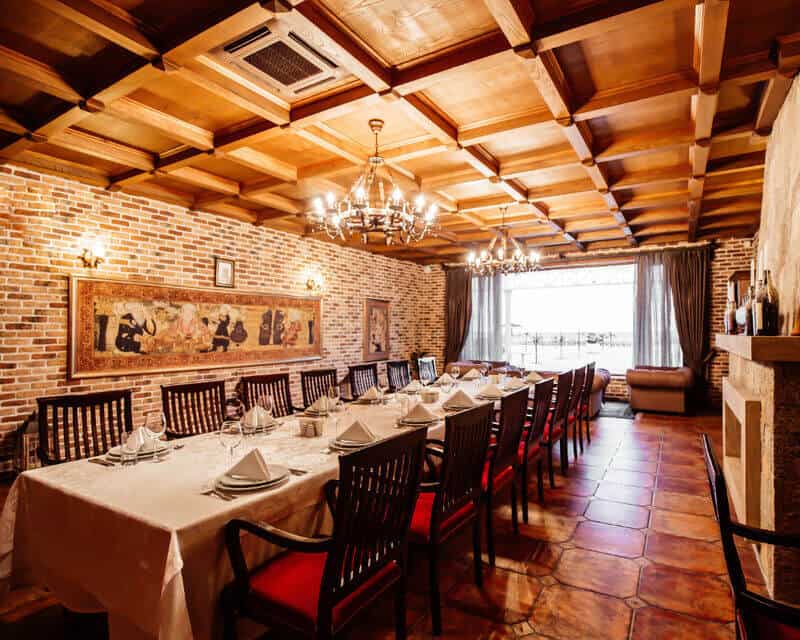Restaurant lighting enhances the aesthetics of the space, highlights the restaurant’s brand and style, and makes reading menus easy. In addition, it often sets the mood, from informal, bright, fast-food lighting to romantic candle illumination. A lighting design that makes your customers feel welcome could boost the success of your restaurant.
Here is everything you need to know when planning your restaurant lighting design.
The Most Popular Types of Lighting in Restaurants

Most restaurant lighting designs incorporate different lighting fixtures working harmoniously with ambient light sources like large windows or skylights. You’ll need to consider everything from illuminating individual tables to bright overhead lights in the kitchen while keeping restaurant trends and your theme in mind.
Hanging Pendant Lights
Pendants are trendy, attractive, and come in many styles and sizes to fit any decor. They are single lights hanging from the ceiling and provide spotlighting where needed above tables, bars, counters, and reception areas.
Chandeliers
While they also hang from the ceiling, chandeliers are usually more ornate than pendants and have many bulbs. Large chandeliers often create an eye-catching focal point in the entrance area or dining room, and smaller chandeliers frequently hang over tables.
Wall Sconces
Sconces are attached to walls and are ideal for providing indirect lighting above pictures, artwork, and other wall decorations. They come in many styles and sizes to fit any decor and are one of the most common restaurant light fixtures.
Track Lighting
Lights attached to a rail are known as track lighting. Each light can be moved either alone on the track or angled separately to illuminate different areas, creating multiple focal points with only one light fixture.
Ceiling Fan Lights
Ceiling fan lights are popular for covered outdoor spaces to provide light and keep diners cool. They may also be found indoors to complement a tropical ambiance or jungle theme.
Recessed Lighting
Set in and flush with ceilings or walls, recessed lighting provides narrow beams of light, usually pointed down. They are often used over the bar, in a hallway, or simply as discreet extra light where needed.
Functional Lighting
Bright ceiling-mounted fluorescent task lights are used in kitchens, dish rooms, and storage areas.
Pole Lighting
Used outside to light sidewalks and walkways, decorative light poles should match your brand aesthetic and complement your decor. Bistro light plans often include pole or string lighting.
10 Things to Consider for Your Restaurant Lighting Design Plan

You can enhance your customer’s dining experience by lighting a restaurant properly. You need to balance practical light with soft, magical lightning that sets the theme of your restaurant. A good restaurant lighting plan is cohesive, financially viable, and useful for the front and back of house.
1. Practicality
Restaurant lighting needs to be practical. Why design a menu and a theme if no one can see the food or read the menu? Functional lighting is a necessity, especially in the back of house, but it isn’t the only kind of lighting to consider.
2. Ambiance
In addition to functional lighting, the front of house also need to be inviting and enchanting. Use ambient, indirect lighting to create a cozy environment or a sense of intimacy. More lights can create a feeling of community and vitality.
3. Color Temperature
The color temperature of the lighting can affect the mood and atmosphere of the space. Warm lighting (reds, yellows, oranges, and ambers) can create a relaxing and intimate ambiance. In contrast, cooler (whites and hues of blue and purple) lighting can create a more modern and sophisticated atmosphere.
4. Brand and Style
The lighting should reflect the brand and style of the restaurant. For example, a sports bar and restaurant may choose full, bright, and colorful lighting, but a fine dining restaurant may want upscale chandeliers and soft lighting from wall sconces.

5. Energy Efficiency
Consider using energy-efficient solutions such as LED lighting that can help reduce energy costs and maintenance expenses in the long run.
6. Maintenance and Durability
Choose restaurant light fixtures that are easy to clean and maintain, as well as fixtures that are durable and long-lasting. Consider lighting options with warranties or guarantees for peace of mind.
7. Safety and Security
Ensure the lighting is bright enough to create a safe and secure environment for customers and staff while providing an inviting atmosphere. Look for lighting fixtures with motion sensors or other features that help reduce energy consumption. It is a good idea to thoroughly light exits, doors, and outdoor spaces.
8. Adjustable Light Options
Regardless of the type of lighting you choose the ability to scale the brightness is important. Lunch patrons want brighter lighting than dinner diners looking to relax at the end of the day. You should be able to raise and lower the lights at different times of the day.
9. Natural Light
The lighting in your restaurant can use ambient lighting from windows, doors, and skylights to create a more pleasant atmosphere. Natural light carries many benefits, including improved mood and increased productivity. Keep your windows clean and use treatments or shades to soften the light.
10. Fire Safety
Regardless of the type of lighting fixtures you choose for your restaurant, fire safety should always be at the forefront of your mind. Make sure all lights are rated safe for the environment they will be in and adequately spaced. Have a fire extinguisher nearby, and make sure your staff knows how to use one. Finally, keep all wiring up to code and secure any lights that need it.
The key to excellent restaurant lighting is layering task-oriented lighting and ambient light sources. You can create an inviting and safe space with the right combination of fixtures. When planning out your restaurant lighting design, make sure to factor in considerations for energy efficiency, fire safety, and cost. That way, you’ll achieve the perfect balance of form and function when it comes time to light up.